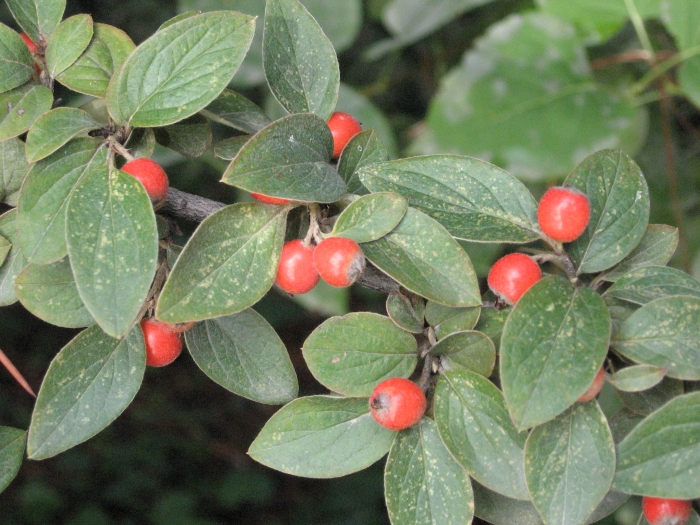Orange Cotoneaster
(Cotoneaster franchetii)
Orange Cotoneaster (Cotoneaster franchetii)
/
/

A. Barra
CC BY 3.0
Image By:
A. Barra
Recorded By:
Copyright:
CC BY 3.0
Copyright Notice:
Photo by: A. Barra | License Type: CC BY 3.0 | License URL: https://creativecommons.org/licenses/by/3.0 | Uploader: Cillas | Publisher: Wikimedia Commons | Title: Cotoneaster_franchetii_2.jpg | Notes: |




















































Estimated Native Range
Summary
Cotoneaster franchetii, commonly known as Orange Cotoneaster, is an evergreen or semi-evergreen shrub that can reach up to 3 meters (9.8 ft) in height. It is native to the scrub and rocky areas in the regions of Southwest China and the Himalayas. The plant is characterized by its arching branches and gray-green leaves with white undersides. The flowers, which bloom in late spring to early summer, are small with pink exteriors and white interiors, arranged in clusters known as corymbs. The showy red pomes, which are about 6–9 millimeters (0.24–0.35 in) in diameter, appear in the fall and are attractive to fruit-eating birds that aid in seed dispersal.
Orange Cotoneaster is valued for its ability to absorb air pollution, particularly along roads with heavy traffic, where it has been shown to be at least 20% more effective than other commonly used roadside shrubs. It is often used for hedges, screens, and bank cover due to its dense foliage and ease of maintenance. This shrub thrives in full sun to part shade and requires medium amounts of water. It is adaptable to a variety of soil types, provided they have adequate drainage. While it is generally disease-resistant, it can be susceptible to fire blight and can become invasive in some regions outside its native range, so gardeners should be cautious about planting it in areas where it may spread uncontrollably.CC BY-SA 4.0
Orange Cotoneaster is valued for its ability to absorb air pollution, particularly along roads with heavy traffic, where it has been shown to be at least 20% more effective than other commonly used roadside shrubs. It is often used for hedges, screens, and bank cover due to its dense foliage and ease of maintenance. This shrub thrives in full sun to part shade and requires medium amounts of water. It is adaptable to a variety of soil types, provided they have adequate drainage. While it is generally disease-resistant, it can be susceptible to fire blight and can become invasive in some regions outside its native range, so gardeners should be cautious about planting it in areas where it may spread uncontrollably.CC BY-SA 4.0
Plant Description
- Plant Type: Shrub
- Height: 6-10 feet
- Width: 4-8 feet
- Growth Rate: Moderate
- Flower Color: White
- Flowering Season: Summer
- Leaf Retention: Evergreen, Semi-Deciduous
Growth Requirements
- Sun: Full Sun, Part Shade
- Water: Medium
- Drainage: Slow, Medium, Fast
Common Uses
Bee Garden, Bird Garden, Butterfly Garden, Deer Resistant, Drought Tolerant, Hedges, Hummingbird Garden, Low Maintenance, Rabbit Resistant, Street Planting
Natural Habitat
Native to scrub and rocky areas in Southwest China and the Himalayas
Other Names
Common Names: Franchet’s Cotoneaster, Franchet-Zwergmispel, Cotonéaster De Franchet, Franchet’S Cotoneaster, Koralloxbär
Scientific Names: , Cotoneaster franchetii, Cotoneaster mairei var. albiflorus, Pyrus franchetii,
GBIF Accepted Name: Cotoneaster franchetii Boiss.